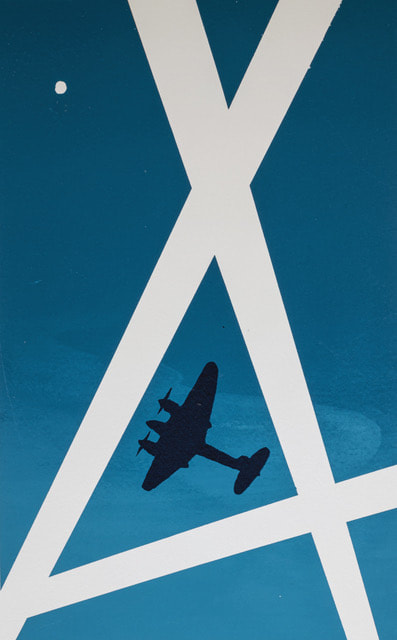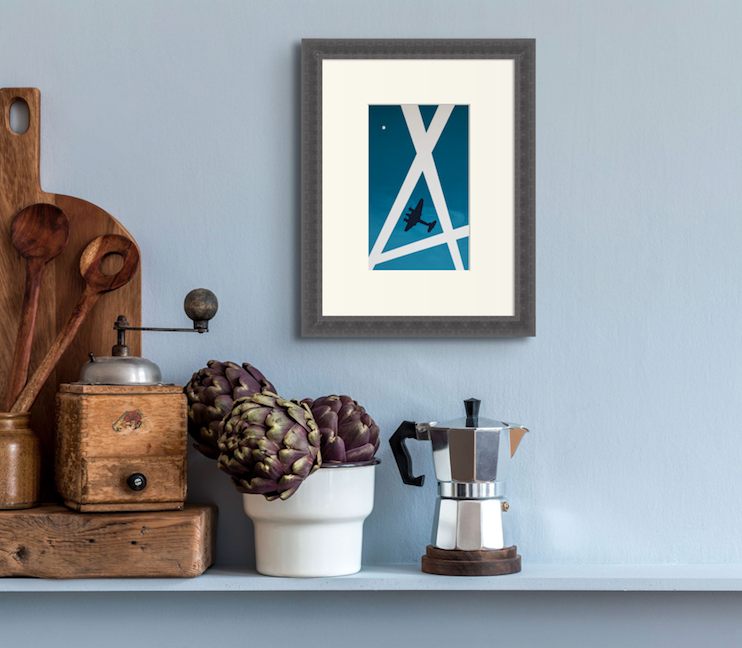Mosquito by Ian Scott Massie
Variable Edition Reduction Screen Print - Edition of 7
16" x 12" Mounted size - 10.5" x 6.5" Image size
Available: unframed @ £130
To shop, please click here
16" x 12" Mounted size - 10.5" x 6.5" Image size
Available: unframed @ £130
To shop, please click here
GEOFFREY DE HAVILLAND
Leaving North London behind, the East Coast Main Line slips under the M25 and approaches Hatfield.
To me the name de Havilland conjures up images of the Hollywood star Olivia de Havilland. But, as child of the 50s, it was also a name synonymous with a string of famous aircraft, named after the designer Geoffrey de Havilland. As a young man Geoffrey worked for car makers Wolseley before designing his first aero engine. With borrowed money he built, and briefly flew, his first plane. Undeterred by its unfortunate crash he immediately built another plane which established a British altitude record.
Landing a job at the Royal Aircraft Factory in 1910, he designed aircraft for the newly-formed Royal Flying Corps before moving to the aircraft company Airco on the eve of the Great War. At Airco he had the freedom to design his own range of aircraft, one of which, the DH 4, became very successful as a bomber. After the war he set up his own business at Edgware, moving it to Hatfield in 1933.
He was involved in the creation of a number of very remarkable aircraft. There was the Gypsy Moth, which was flown solo by Amy Johnson from London to Australia in 1930. Later, during World War 2, the “Wooden Wonder”, the DH Mosquito, the fastest British fighter/bomber of the conflict. In 1952, the company produced the world’s first pressurised commercial jet airliner, the Comet. Around 50% faster than its piston-engined rivals, the Comet set the standards for the new age of air travel.
de Havilland continued to fly into his 70s leaving behind an impressive range of ground-breaking designs which changed, not just the history of flying, but, with his creation of the first jet airliner, the way we do business and take our holidays.
To me the name de Havilland conjures up images of the Hollywood star Olivia de Havilland. But, as child of the 50s, it was also a name synonymous with a string of famous aircraft, named after the designer Geoffrey de Havilland. As a young man Geoffrey worked for car makers Wolseley before designing his first aero engine. With borrowed money he built, and briefly flew, his first plane. Undeterred by its unfortunate crash he immediately built another plane which established a British altitude record.
Landing a job at the Royal Aircraft Factory in 1910, he designed aircraft for the newly-formed Royal Flying Corps before moving to the aircraft company Airco on the eve of the Great War. At Airco he had the freedom to design his own range of aircraft, one of which, the DH 4, became very successful as a bomber. After the war he set up his own business at Edgware, moving it to Hatfield in 1933.
He was involved in the creation of a number of very remarkable aircraft. There was the Gypsy Moth, which was flown solo by Amy Johnson from London to Australia in 1930. Later, during World War 2, the “Wooden Wonder”, the DH Mosquito, the fastest British fighter/bomber of the conflict. In 1952, the company produced the world’s first pressurised commercial jet airliner, the Comet. Around 50% faster than its piston-engined rivals, the Comet set the standards for the new age of air travel.
de Havilland continued to fly into his 70s leaving behind an impressive range of ground-breaking designs which changed, not just the history of flying, but, with his creation of the first jet airliner, the way we do business and take our holidays.





